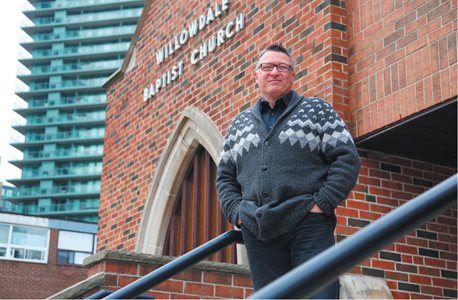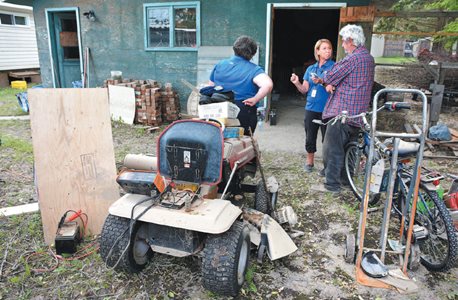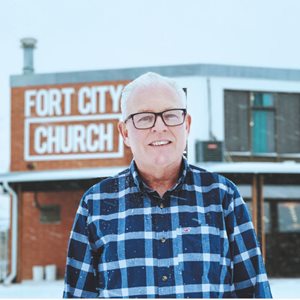Local churches are uniquely positioned to be a comfort in terrible times
September 2018: When Hurricane Florence hit the Ottawa, Ont., area, Samaritan’s Purse responded with volunteers to help remove rubble and comfort those affected.
On Monday, April 23, 2018 pastor Bruce Jones worked from his home office. He is senior pastor of Toronto’s Willowdale Baptist Church, just a stone’s throw from Yonge and Finch, one of the city’s busiest intersections. Just after lunch his phone rang. It was a member of the congregation asking Jones if he knew what was unfolding in their church’s neighbourhood.
Jones turned immediately to breaking news reports about a van that had mounted the sidewalk and plowed through pedestrians on Yonge Street. The driver killed ten people, injured 16 and deeply wounded a vibrant and multicultural neighbourhood.
"That is our corner. Willowdale Baptist is right there," Jones remembers thinking. On the news coverage Jones could see the doors of the church. He knew the church had to do something, and quickly. "We were so close. The closest church to the carnage and the closest to the memorial that popped up. It is a 30-second walk from the corner of our church."
Thousands of people – including media and first responders – would make their way to that corner in the hours, days and weeks that followed. The very first thing Willowdale Baptist did was throw open their doors and parking lot for visitors to enter and use.
CREATING A REFUGE
"We wanted to open up to be a place of refuge, a place of peace and a place of prayer," says Jones. That included placing a sandwich board sign outside inviting people to come in for free coffee, to use the washrooms, have a quiet space in which to sit and pray and reflect, and a convenient spot for media to park their vehicles.

In the aftermath of the toronto
JOEL GORDON
April 2018: In the aftermath of the Toronto van attack, Pastor Bruce Jones and his team at Willowdale Baptist were able to minister in a host of ways to their community.
"We wanted to provide some comfort," says Jones. Willowdale Baptist wasn’t alone. Within an hour, rapid response chaplains from the Billy Graham Evangelistic Association showed up ready for their work, which includes quietly approaching grieving people and asking if they can help. The next day Marion Goertz, a Christian therapist who directs Tyndale University’s Family Life Centre, arrived to offer her team’s services as well.
"The thing that kept blowing me away," says Jones, "was we didn’t know what was going to happen when we opened up the church doors. We just knew we had to. It was after we made the decision to minister to the community that the Lord brought all the people together who were able to minister a sense of the Lord’s presence, even in the midst of the chaos."
That initial offering of space and place was immediate and almost spontaneous. At the same time, a more planned-out approach was also in the works taking advantage of the interchurch collaboration that already existed in that neighbourhood.
Joel Gordon was creative and community pastor at Willowdale Baptist when the tragedy happened. He says the churches in the neighbourhood knew each other well and had good working relationships already in place, plus a convenient way to message each other already established on WhatsApp, a messaging platform. That all helped.
"We gathered as a group and prayed, and discerned, and had strategic discussions about what we would do collectively, and that informed what we did at the local congregational level," says Gordon. "We participated in what was agreed on as a collective group."
Collective actions included organized vigils and interfaith ceremonies. Willowdale Baptist also offered a grief support group they advertised widely in the community and held in the months following the attack.
"We planned for an immediate response, a short-term response over 26 days and a long-term response," says Gordon. "Being open and welcoming, that was our main strategy."
That strategy helped countless grieving people manage the shock and pain of what happened on that Toronto street on that horrible day. That same spirit has helped churches respond effectively to disasters as well as tragedies.
FIRES THAT KEEP BURNING
On May 1, 2016 a wildfire sparked to life just outside Fort McMurray, Alta. Two days later it blazed through the city, evacuating more than 88,000 people from their homes and eventually destroying 2,400 homes and businesses. Doug Doyle is lead pastor at Fort City Church, and he remembers evacuation day like it was yesterday.

In the middle of the flood-damaged possessions
PHOTO: BILLY GRAHAM RAPID RESPONSE TEAM
May 2018: In the middle of the flood-damaged possessions of his Grand Forks, B.C. home, Leo and Billy Graham Rapid Response Team chaplain Janet Voth share in a discussion about faith.
"My family and I left Fort McMurray with fire literally on either side of our vehicle. I was beside the Super 8 that was burning, and they moved us to another lane."
As Doyle maneuvered his car out of town, he received a call from a pastor in Edmonton offering to help in whatever way he could. "In the middle of the fire, we were going into strategic thinking mode," remembers Doyle.
Eventually, from the safety of that pastor’s church, Beulah Alliance in Edmonton, Doyle and his team would live stream their church services to their congregants wherever they ended up (including to first responders from his own Fort McMurray congregation who were still in that city), and received special permission from the fire chief to use their church building during the weeks spent fighting the fire.
"They got the permission to use the building to gather for spiritual care and Bible study. They took our stream services, and they would gather every Sunday and watch it there. You would get first responders coming in for a bit of spiritual strength," says Doyle.
Spiritual care would go on to be the defining flavour of the love shown by Fort City Church to their broader community. To this day, well on the way to three years after the fire, Doyle still mentions the wildfire and its impact regularly from the platform to address the pain that is ongoing as community members work out issues of PTSD, and prolonged homelessness and insurance issues.
The church also offered practical help, but not in the form people might have expected.
"Each church is different," says Doyle. "I think a lot of churches went big on just giving stuff out, and in a city like Fort McMurray that was nice for a while, but what we thought they really needed was a church to speak hope, to pray, to create a space where people could talk and listen. The stuff was helpful, but it wasn’t necessarily what people needed the most."
MORE THAN STUFF
Fort City Church wasn’t "the stuff church," explains Doyle. "We were the ‘Let’s help you move stuff, let’s help you clean up your yard.’ Then we got involved in ash sifting, helping people find their valuables – talk about a powerful ministry!" That is one of the ministries Samaritan’s Purse Canada facilitates, helping homeowners sort and sift through the skeletal remains of their homes looking for what traces of special belongings might remain. The Christian charity used Fort City Church as one of their base churches – they call them lighthouse churches – as they helped Fort McMurray recover from the fire.

Viewable Image - after fire ravaged fort mcmurray, alta
Image Caption
PHOTO: FORT CITY CHURCH
After fire ravaged Fort McMurray, Alta., in May 2016, Pastor Doug Doyle and Fort City Church were able to show Christ to their neighbours in very tangible ways – and continue to do so.
"We recognize that churches, for good reason, don’t have a lot of experience working with disasters," says Brent Davis, response director for Samaritan’s Purse Canada. "We bring equipment and leadership into a community, and partner alongside the local church. We help the church help their neighbours recover. The church is already there, connected to their community. They know their community. They know the vulnerable people in their neighbourhood – they are already working with them."
Churches, says Davis, are "perfectly equipped to blend practical help with spiritual truth and encouragement. I don’t know any other group that does that, that stands inside the soot and slop of someone’s home with the message of hope from Jesus Christ."
Keep in mind the first responder in any disaster, says Davis, is the neighbour – and Christians and their local church are ideally situated to be that first-responding neighbour who helps well.
THE NEIGHBOUR STRATEGY
Individual Christians can be prepared at the household level for a potential disaster by having an emergency kit in their homes and vehicles. Kits can easily be put together following online assembly lists, or even purchased premade. This can make Christians in communities better prepared and equipped to help others when tragedy or disaster strikes.
At the congregational level, the first step to being ready to help is to realize tragedy and disasters can – and do – happen anywhere.
"We’ve seen these disasters paralyze the church as much as they do the community, and that makes it difficult for the church to respond," says Davis. "It’s human nature to think bad things won’t happen to us. Get over that mental hurdle and you can start planning. What’s the most likely thing to happen in your community? Is it a flood, a tornado, an extended power outage?"
This kind of thinking, says Davis, is simple risk analysis and, "It’s no more complicated than sitting down and dreaming out what could happen, what is likely, what would be the impact on us and on the community, and on our ability to serve the community. Then ask, ‘How do we mitigate that? How do we put things in place so if something does happen, we are ready?’"
PLAN FOR A MARATHON, NOT A SPRINT
In an era of what seems like increasing incidences of expressions of public violence, like the van attack in Toronto, that list can include questions about how the local church is equipped to walk with their communities through periods of shocking and intense grief stemming from violent acts. Whether it is a natural or manmade disaster or tragedy, churches should plan to be available to and with their community for the long haul.
"We refer to disasters as a marathon," says Davis, "not a sprint. When safety has been taken care of, that’s when the long job of recovery begins. It’s always a new normal. It creates a lot of need in the community, and churches can start to think about how they’re going to pivot to meet the ongoing needs of the community going forward."
Both Bruce Jones and Doug Doyle, pastors facing very different situations in their very different communities, know this long-term reality well.
Jones says that Marion Goertz, the therapist who came from Tyndale, "Told us it might be weeks or even months later that the heaviest needs come out in lives because of a tragedy like this. Both a short- and long-term response is important."
In Fort McMurray the trauma, the rebuilding and the consolation offered by the Church continues.
"I continue to encourage churches, ‘You’ve got to keep talking about it,’" says Doyle. "You don’t avoid it. We are a sin-wrecked world where life is not safe. Your home might burn, but Jesus turns up in the middle of that and He’s walking with us."
 Listen to our interview with Merle Doherty, manager of the rapid response team of the Billy Graham Association of Canada. You'll also find other interviews at www.TheEFC.ca/Podcasts.
Listen to our interview with Merle Doherty, manager of the rapid response team of the Billy Graham Association of Canada. You'll also find other interviews at www.TheEFC.ca/Podcasts.